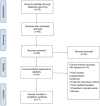Systematic review and meta-analysis of the etiology of heavy menstrual bleeding in 2,770 adolescent females
- PMID: 38378571
- PMCID: PMC10880246
- DOI: 10.1186/s12905-024-02921-7
Systematic review and meta-analysis of the etiology of heavy menstrual bleeding in 2,770 adolescent females
Abstract
Background: Adolescent heavy menstrual bleeding(HMB), menorrhagia or abnormal uterine bleeding commonly occur in adolescent women. The differential diagnosis can be challenging. The pneumonic: PALM-COEIN (polyp, adenomyosis, leiomyoma, malignancy and hyperplasia, coagulopathy, ovulatory dysfunction, endometrial, iatrogenic, and not yet classified), is commonly used but it does not stratify as to the likelihood of a disorder. We have sought to develop a probability-based differential diagnosis for Adolescent HMB, menorrhagia or abnormal uterine bleeding.
Methods: A comprehensive literature search was conducted using PubMed, EMBASE, and SCOPUS databases. Case series describing adolescents from 10-19 years of age with HMB, menorrhagia or abnormal uterine bleeding was acceptable if: more than 10 patients were included; editorials, case reports, and secondary sources such as review articles, or book chapters were excluded. No language filter was used, but an English abstract was required. The etiology of HMB, menorrhagia or abnormal uterine bleeding, and the country of origin was extracted from articles that met inclusion criteria. Cumulative rate estimates were determined by Bayesian probability modeling.
Results: Seventeen full text articles were reviewed in detail; 2,770 patients were included. The most frequent causes of HMB were Ovarian Uterine Disorders (23.7%; 95% CredI 22-25.5%), Coagulation Disorders (19.4%; 95% CredI 17.8-21.1%), and Platelet Disorders (6.23%; 95% CredI 5.27-7.27%) with 45.9% (95% CredI 43.8-47.%9) of the cases of indeterminate origin.
Conclusions: The leading causes of HMB in healthy adolescent females were varied. The sub-analysis identified distinct etiologies, suggesting that multiple factors must be considered in the evaluation of HMB. While PALM-COEIN (polyp, adenomyosis, leiomyoma, malignancy and hyperplasia, coagulopathy, ovulatory dysfunction, endometrial, iatrogenic, and not yet classified) provides us with a comprehensive picture of the possible causes of HMB in females, this systematic review assigns probabilities to the etiologies of HMB in adolescent females, providing physicians with a more focused and efficient pathway to diagnosis.
Keywords: Abnormal uterine bleeding; Adolescents; Heavy menstrual bleeding; Menorrhagia; PALM-COEIN; Systematic review.
© 2024. The Author(s).
Conflict of interest statement
The authors declare no competing interests.
Figures
Similar articles
-
Evaluation and management of abnormal uterine bleeding.Med J Malaysia. 2022 May;77(3):374-383. Med J Malaysia. 2022. PMID: 35638495
-
Comparison of classic terminology with the FIGO PALM-COEIN system for classification of the underlying causes of abnormal uterine bleeding.Int J Gynaecol Obstet. 2016 Jun;133(3):325-8. doi: 10.1016/j.ijgo.2015.09.033. Epub 2016 Feb 16. Int J Gynaecol Obstet. 2016. PMID: 26952349
-
Contemporary evaluation of women and girls with abnormal uterine bleeding: FIGO Systems 1 and 2.Int J Gynaecol Obstet. 2023 Aug;162 Suppl 2(Suppl 2):29-42. doi: 10.1002/ijgo.14946. Int J Gynaecol Obstet. 2023. PMID: 37538019 Free PMC article.
-
Uterine disorders and iron deficiency anemia.Fertil Steril. 2022 Oct;118(4):615-624. doi: 10.1016/j.fertnstert.2022.08.011. Fertil Steril. 2022. PMID: 36182260 Review.
-
Pathophysiology of heavy menstrual bleeding.Womens Health (Lond). 2016 Jan;12(1):3-13. doi: 10.2217/whe.15.81. Epub 2015 Dec 23. Womens Health (Lond). 2016. PMID: 26695831 Free PMC article. Review.
Cited by
-
Menstrual Disorders in Adolescence: Diagnostic and Therapeutic Challenges.J Clin Med. 2024 Dec 16;13(24):7668. doi: 10.3390/jcm13247668. J Clin Med. 2024. PMID: 39768589 Free PMC article. Review.
References
-
- Screening and management of bleeding disorders in adolescents with heavy menstrual bleeding. ACOG. https://www.acog.org/clinical/clinical-guidance/committee-opinion/articl.... Accessed 2021.
Publication types
MeSH terms
LinkOut - more resources
Full Text Sources
Miscellaneous


